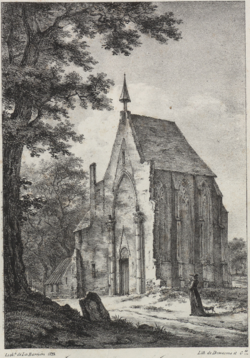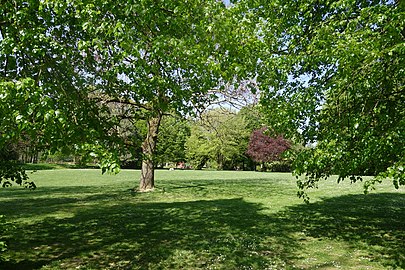Scheut
Scheut | |
|---|---|
 Former chapel of Scheut (1823) | |
| Coordinates: 50°50′51″N 4°18′27″E / 50.84750°N 4.30750°E | |
| Country | |
| Region | Brussels-Capital Region |
| Municipality | Anderlecht |
Scheut is a district of Anderlecht, a municipality of Brussels, Belgium. Located in the north of Anderlecht, it is bounded by the border with the municipality of Molenbeek-Saint-Jean to the north, the historical centre of Anderlecht to the south, the Birmingham district to the east, the Scheutveld district to the west and the semi-natural site of the Scheutbos to the north-west.
The district is crossed by the Chaussée de Ninove/Ninoofsesteenweg running east–west and is served by the metro stations Aumale, Jacques Brel, and Gare de l'Ouest/Weststation (Brussels-West Station).
History
Origins and medieval times
In 1356, the Count of Flanders, Louis II, fought against Brussels on the territory of Anderlecht, in the so-called Battle of Scheut, supposedly over a monetary matter. Although he defeated his sister-in-law, the Duchess of Brabant, Joanna, and briefly took her title, she regained it the following year with the help of the Holy Roman Emperor, Charles IV. In 1393, Joanna's charter made Anderlecht a part of Brussels.

In 1454, the Carthusian Monastery of Our Lady of Grace was founded in Scheut. Due to the wars of religion, it was abandoned by 1578. It was rebuilt in the 1580s, but the monastery was finally transferred to Brussels. On the site of the Carthusian Monastery stood a chapel called Our Lady of Scheut, whose pleasant location, in the middle of a grove, made this place very popular at the time.
15th–18th centuries
The 17th and 18th centuries were marked by the wars between the Low Countries and France. During the Nine Years' War, it is from the high ground of Scheut that the bombardment of Brussels of 1695 took place. Together with the resulting fire, it was the most destructive event in the entire history of Brussels. On 13 November 1792, right after the Battle of Jemappes, General Dumouriez and the French Revolutionary army routed the Austrians there once again. Among the consequences were the disbanding of the canons and Anderlecht being proclaimed an independent municipality by the French.
19th century and later
It is also in this district, on the Chaussée de Ninove/Ninoofsesteenweg, that lay the foundations of the Scheutveld College, on 28 April 1863, by the Catholic priest Theophile Verbist. The congregation of Scheut Missionaries went on to evangelise China, Mongolia, the Philippines, as well as the Congo Free State/Belgian Congo (modern-day Democratic Republic of the Congo).[1][2] The old chapel was incorporated into the Scheutistes' church, but was demolished in 1974 to make way for a supermarket. The then-curator of the Erasmus House (a museum in Anderlecht devoted to the Dutch humanist writer Erasmus of Rotterdam) was able to save the carved corbels and keystones at the last minute. These were recently attributed to Rogier van der Weyden.
Sights
- The Church of St. Vincent de Paul, a former Art Deco Roman Catholic church built in 1935–1937. Its presbytery and outbuildings were converted into a new school, which opened in 2018.[3][4]
- The Museum of China – Scheut, which houses documents and pieces brought back to Europe by the congregation of Scheut Missionaries, including a 15th-century bronze Buddha.[5]
- The Parc Forestier/Bospark, located in the former Anderlecht Cemetery. The old cemetery's monumental entrance and walls still surround the park to this day.[6]
- The main police station of the 5341 Brussels South police zone: Anderlecht, Forest and Saint-Gilles.[7]
-
Church of St. Vincent de Paul
-
Entrance of the Parc Forestier/Bospark
-
Inside the Parc Forestier
See also
References
Notes
- ^ Verhelst & Pycke 1995.
- ^ Vanysacker & Renson 1995, p. 36–37.
- ^ "Eglise Saint-Vincent de Paul – Inventaire du patrimoine mobilier". collections.heritage.brussels (in French). Retrieved 5 July 2022.
- ^ "Eglise Saint-Vincent-de-Paul (Scheut) - Informations sur l'édifice - Orgues en Région de Bruxelles-Capitale". www.orgues.irisnet.be. Retrieved 5 July 2022.
- ^ Fun, Everything is (10 March 2017). "Museum of China - Scheut". Brussels Museums. Retrieved 14 December 2019.
- ^ "Parc forestier". Brussels Gardens (in French). Retrieved 5 July 2022.
- ^ "Police zone Midi 5341: Anderlecht/Saint-Gilles/Forest — Région bruxelloise - Brussels Gewest". be.brussels. Retrieved 5 July 2022.
Bibliography
- Verhelst, Daniël; Pycke, Nestor (1995). C.I.C.M. Missionaries Past and Present: History of the Congregation of the Immaculate Heart of Mary (Scheut/Missionhurst). Verbistiana. Vol. 4. Leuven: Leuven University Press. ISBN 978-90-6186-676-3.
- Vanysacker, Dries; Renson, Raymond (1995). The Archives of the Congregation of the Immaculate Heart of Mary (CICM-Scheut) (1862–1967) - 2 v. Rome: Bibliothèque de l'Institut Historique Belge de Rome. ISBN 978-90-74461-15-3.





